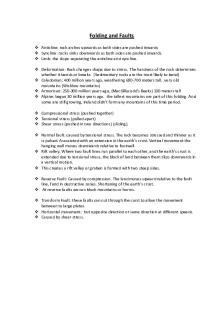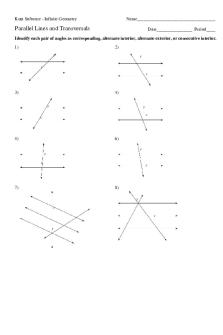4. Folding, fold mountains Faults lines and types PDF

| Title | 4. Folding, fold mountains Faults lines and types |
|---|---|
| Course | German Cultural History |
| Institution | Trinity College Dublin University of Dublin |
| Pages | 2 |
| File Size | 55.5 KB |
| File Type | |
| Total Downloads | 38 |
| Total Views | 150 |
Summary
1st year chemistry lab on Thermochemistry, the difference in temperature between the start and end of the reaction and graphing the results....
Description
Folding and Faults Anticline: rock arches upwards as both sides are pushed inwards Syncline: rocks sinks downwards as both sides are pushed inwards. Limb: the slope separating the anticline and syncline. Deformation: Rock changes shape due to stress. The hardness of the rock determines whether it bends or breaks. (Sedimentary rocks are the most likely to bend) Caledonian: 400 million years ago, weathering 600-700 meters tall, very old mountains (Wicklow mountains) Armorican: 250-300 million years ago, (MacGillycudd’s Reeks) 100 meters tall Alpine: began 30 million years ago. the tallest mountains are part of this folding. And some are still growing, Ireland didn’t form any mountains of this time period. Compressional stress (pushed together) Tensional stress (pulled apart) Shear stress (pushed in two directions) (sliding). Normal fault: caused by tensional stress. The rock becomes stressed and thinner as it is pulsed. Associated with an extension in the earth’s crust. Vertical movement the hanging wall moves downwards relative to footwall. Rift valley: Where two fault lines run parallel to each other, and the earth’s crust is extended due to tensional stress, the block of land between them slips downwards in a vertical motion. This creates a rift valley or graben is formed with two steep sides. Reverse Fault: Caused by compression. The land moves upward relative to the fault line, fund in destructive zones. Shortening of the earth’s crust. At reverse faults we can block mountains or horsts. Transform Fault: these faults can cut through the curst to allow the movement between to large plates. Horizontal movement: but opposite direction or same direction at different speeds. Caused by shear stress.
1. A fold is the bend in the rock formed when the rock is being pushed from both sides. 2. Rocks but under stress are pushed up as the force acts on them. 3. Rocks on the surface are more brittle and tend to break when put under stress while rocks in the crust are more liquid due to heat. 4. Anticline: rock arches upwards as both sides are pushed inwards Syncline: rocks sinks downwards as both sides are pushed inwards. Limb: the slope separating the anticline and syncline. 1. 2. 3. 4. 5. 6. 7.
Orogeny is the creation of mountains. Caledonian, Armorican, Alpine It started 30 million years ago. Examples of countries were it happened are France, Switzerland and Italy. The alps and the Himalayas. As Ireland is far away from the plate edge it didn’t get any mountain creation. It experienced volcanic activity mainly in the north of the island.
Short questions i. Asymmetrical fold: b Over thrust fold: A Symmetrical fold: D ii. Caledonian, Armorican....
Similar Free PDFs

Protein Folding Diseases
- 5 Pages

Waiting Lines and Simulation
- 2 Pages

Offsets and tie lines
- 31 Pages

FOLDING E CONTROLLO DELLE PROTEINE
- 30 Pages

Folding bike research
- 2 Pages

Q 4 Personality Types
- 2 Pages

TANGENT PLANES AND NORMAL LINES
- 5 Pages

4-Types complexes
- 11 Pages

4 Primary Tissue Types
- 5 Pages

D Parallel and Perpendicular Lines
- 10 Pages
Popular Institutions
- Tinajero National High School - Annex
- Politeknik Caltex Riau
- Yokohama City University
- SGT University
- University of Al-Qadisiyah
- Divine Word College of Vigan
- Techniek College Rotterdam
- Universidade de Santiago
- Universiti Teknologi MARA Cawangan Johor Kampus Pasir Gudang
- Poltekkes Kemenkes Yogyakarta
- Baguio City National High School
- Colegio san marcos
- preparatoria uno
- Centro de Bachillerato Tecnológico Industrial y de Servicios No. 107
- Dalian Maritime University
- Quang Trung Secondary School
- Colegio Tecnológico en Informática
- Corporación Regional de Educación Superior
- Grupo CEDVA
- Dar Al Uloom University
- Centro de Estudios Preuniversitarios de la Universidad Nacional de Ingeniería
- 上智大学
- Aakash International School, Nuna Majara
- San Felipe Neri Catholic School
- Kang Chiao International School - New Taipei City
- Misamis Occidental National High School
- Institución Educativa Escuela Normal Juan Ladrilleros
- Kolehiyo ng Pantukan
- Batanes State College
- Instituto Continental
- Sekolah Menengah Kejuruan Kesehatan Kaltara (Tarakan)
- Colegio de La Inmaculada Concepcion - Cebu





